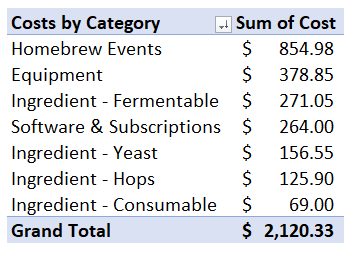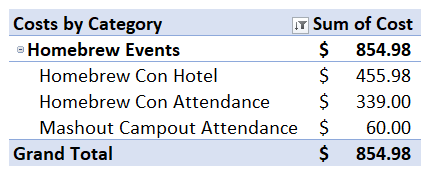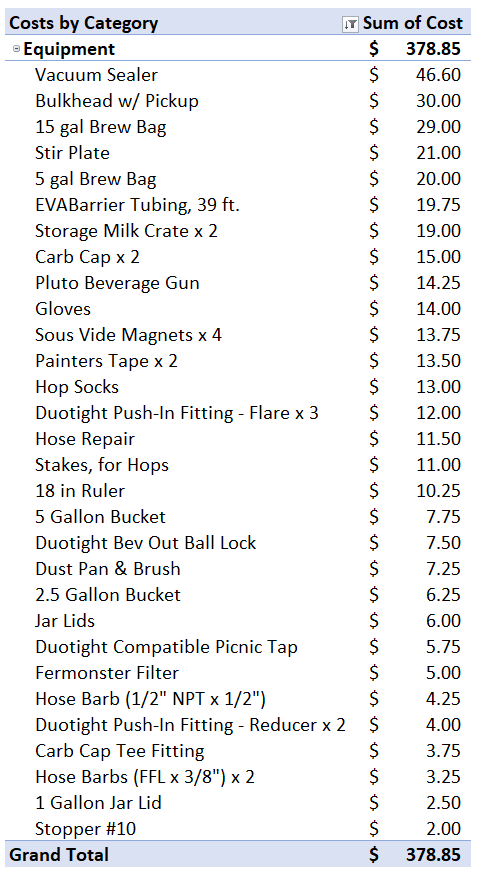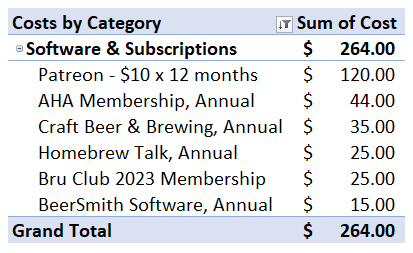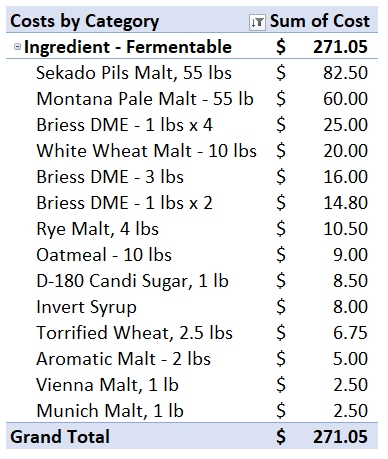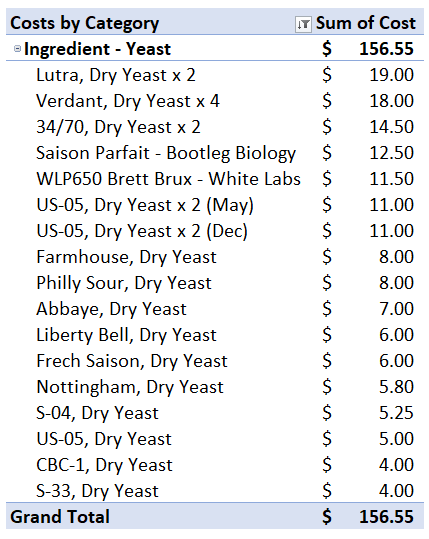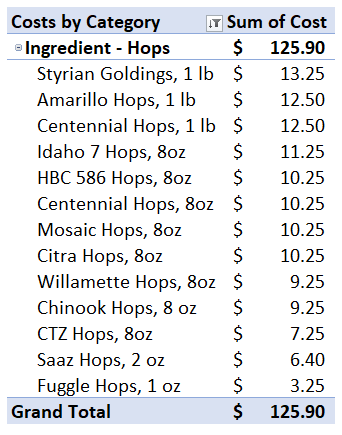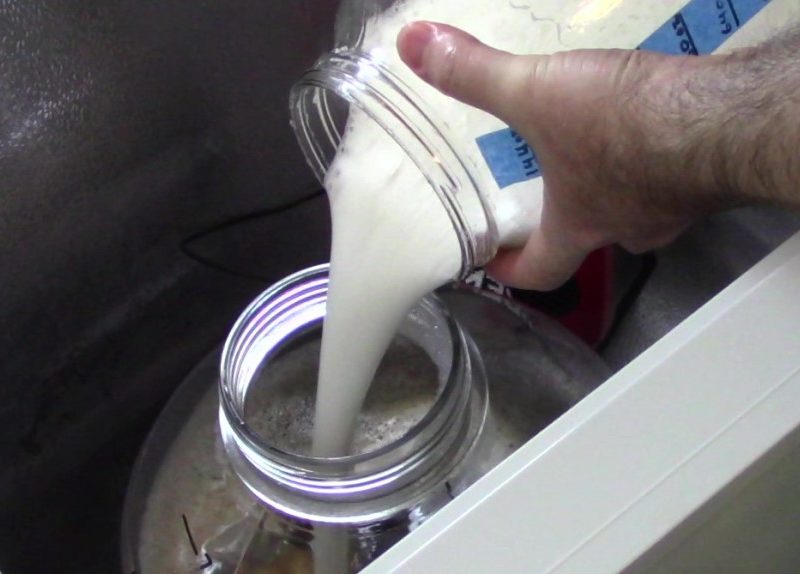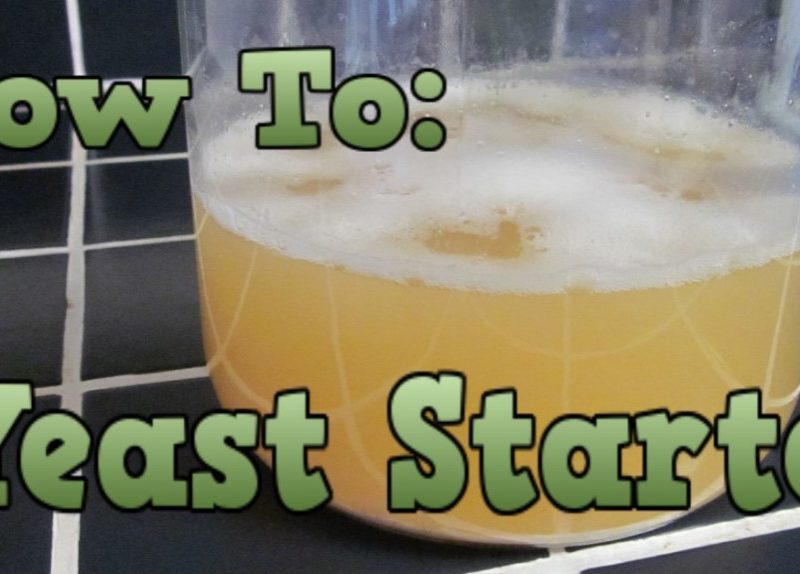In part two of my Homebrewing Costs series I take a closer look at all my homebrew purchase expenses for 2022. I have been homebrewing for nearly 30 years, so I have all the equipment needed. When I looked back at my total expenses, I was a little but surprised how much I spent.
Overview
As I write this article, I have been brewing beer for nearly 30 years. I consider myself a frugal homebrewer, though I would not call myself a cheapskate. The equipment I use is fairly modest, it has been acquired over decades of brewing, and many key pieces were free or low cost. I often purchase ingredients like grain and hops in bulk. I will reuse yeast and I use a lot of dry yeast these days.
I know that my investigative brewing style, and brewing batches geared toward making interesting YouTube content, does add some extra costs. For example, I might split a batch with two or more different yeasts or purchase some ingredients that seem interesting to try out.
In this article I look closer at my homebrew purchase expenses. These are the costs when a homebrew related item is purchased. This might be in ingredient, equipment, or an item used in the process of homebrewing. In a following article, I will try to break down costs per specific batch.
Tracking Homebrew Purchase Expenses
Process
In my introduction article, I provided an overview of the benefits and negatives of tracking homebrew purchase expenses and I also described my approach to tracking costs. I won’t go into detail here. Essentially, when I made a homebrew related purchase, such as a bag of hops, a container of sanitizer or replacement tubing, I entered the cost into a spreadsheet. In some cases, I had to make a judgement call if that pack of oatmeal, sugar or cleaning detergent was an actual homebrew expense.
The fields I captured for each purchase were:
- Date
- Category
- Store
- Description
- Cost
Aside from Category, all the fields are pretty self-explanatory. In the next section I will describe how I came up with categories.
Defining Categories
I decided it would be useful to break down my purchase costs into various buckets. The exact categories evolved through the year. My categories may change in future year, and you might find a different set of categories work for you.
The categories I used for 2022, in alphabetical order, are:
- Equipment
- Homebrew Events
- Ingredient – Consumable
- Ingredient – Fermentable
- Ingredient – Hops
- Ingredient – Yeast
- Software & Subscriptions
Total Homebrew Purchase Expenses
Cutting straight to the chase:
I spent $2,120.33 on homebrew purchases in 2022!
Did that number surprise you? It surprised me. There are a few larger expenses in there that I can probably remove to create a more realistic picture of my actual homebrew expenses.
The following table displays my total costs by category. The categories are listed in descending order by total with the largest expenses at the top.
My largest category was Homebrew Events. What is that? I will look closer into this category to see what those expenses are included. I don’t feel like I spend much money on equipment, but Equipment came in second place with almost $380 in costs. I will also dig into the Software & Subscriptions category and the four Ingredient categories.
Homebrew Purchase Expenses by Category
Let’s dig into the different categories of homebrew expenses.
Homebrew Events Costs
At the top of my homebrew purchase expenses is a category named Homebrew Events that totaled $855.
My largest homebrew expenses are related to Homebrew Con 2022, both for the cost of attendance and the cost of the hotel. These combined costs were $795. As the name implies, Homebrew Con is a large homebrewing conference hosted by the American Homebrewers Association. In 2022 the conference was in Pittsburgh, which is about a 4-hour drive for me. Is it fair to include this as a homebrewing expense? On one hand, it was directly homebrewing focused. I learned more about homebrewing, and I came home with well over $100 in homebrewing ingredients. On the other hand, I am willing to discount these as more of a vacation expense.
The other event cost was for 2022 MASHOUT. This is the Mid-Atlantic States Homebrew Campout. You could also debate if this $60 cost should be included. Another view is that homebrewing also opens up access to many free or low-cost events. It is hard to image many other events that include 3 night of camping, organized events, food, and near unlimited homebrew for this price. Yeah, I did bring along homebrew and food to share.
I also attended several homebrew club events and spent evenings drinking homebrew with friends. These events don’t show up in the spreadsheet because there were no costs. Maybe brewing beer does actually save money?!?
Take Away: I am sure I spent more on events than the typical homebrewer. I tend to look at my trip to Homebrew Con as more of a vacation than a homebrew expense. I am willing to subtract this from my overall homebrewing expenses.
Equipment Costs
I was a little surprise the Equipment came in as the number 2 most expensive category at almost $380 dollars.
My most expensive item was an Inkbird vacuum sealer that was on sale for only $46. An inexpensive, and also on sale, Stir Plate is in the list at only $21. There were also a handful of purchases for my new to me 15-gallon kettle. While the kettle was free and included a ball valve, I added in a pickup tube, upgraded bulkhead, a brew bag and a couple barbs. Those items added $66 in costs. While ordering the larger brew bag from Wilser Bags, I also picked up one custom sized to my 5-gallon kettle and a few hop sacks. That added in another $33.
The rest of my equipment costs consistent mostly of minor purchases. I was long overdue with replacing some beverage lines, so I picked up a roll of EVA Barrier line along with a couple different connectors and items to evaluate (including a Pluto Beverage Gun for $14).
Most of the remaining items were inexpensive items, the types of purchases that can be easy to overlook. These are items like a few folding crates to make storing bottled beer easier, rubber gloves for cleaning and squeezing my brew bag, a brush and dust pan set to keep with my grain mill, a couple buckets, etc.
Take Away: My $380 of equipment costs is likely higher than my average year. While I did not make any large equipment purchases, I did purchase a few nice-to-have items. I view the idea that an established homebrewer will have zero equipment costs as a fallacy.
Software and Subscription Costs
My Software and Subscription costs, totally $264, is another area that might be seen as optional.
The biggest expense is completely optional, $10 per month to Patreon to support two homebrewing related podcasts totalling $120 for the year. I also have an AHA subscription and I subscribe to the, very well done, Craft Beer and Brewing magazine. I am a paid member of the Homebrew Talk forum, and I paid for a 2023 membership of the Bru Club (an online brew club that is affiliated with Brulosophy). A BeerSmith software subscription also costs me $15 per year.
Take Aways: I could easily reduce my spending, but I enjoy the benefits that I get from my various subscriptions. I have enough money that I do not mind spending a bit extra to support resources that support the homebrewing community and hobby.
Fermentable (Ingredient) Costs
Fermentables tend to be the most expensive portion of a batch of homebrewed beer, so it is not surprising that the Fermentables category was my most expensive Ingredient category at $271.
The purchases here are not surprising. I purchased two bulk sacks of base grains, several different packages of dry malt extract (DME), specialty grains, and a couple types of sugar.
Take Away: Seems pretty expected and typical. I probably spend more money on DME than a typical all-grain brewer, but I enjoy the ease of making small trial batches with DME.
Yeast (Ingredient) Costs
I spent $157 on yeast in 2022.
I have been using a lot more dry yeast over the past few years, and this list shows that. The only liquid yeast purchases were for a recent Saison with Brett pitched into half. Looking at my batches brewed, I see two that used liquid yeast strains harvested from prior batches and one that used a free pack of Imperial Pub. Dry yeast stores well, so a number of these packs are still in my fridge. Peeking forward to my per batch costs, I count up that I actually brewed with $132 worth of yeast.
Split batches, where I brew a 5-gallon batch and split it into two with one pack of yeast into each fermenter, likely drives up my yeast costs a little. I also often purchase yeast at my local homebrew shops. They are not the cheapest source, but I do try to support these small local businesses.
Take Away: I am sure I could save money on yeast with a few strategies, but overall, my yeast costs seem reasonable.
Hop (Ingredient) Costs
I purchased $119 worth of hops in 2022.
I am not sure if my hop purchase pattern is typical. I have a hard time purchasing hops on my local stores for over $3 per ounce when online vendors often sell good quality hops for less than $1 per pound when purchased in 8-ounce or 16-ounce bags. I have a few single ounce purchases from my local shops, but the vast majority are from online vendors.
I almost ended the year with very little money spent on hops. For most of the year I was focused on using up the hops I had on hand. Toward the end of the year, I was running low or was out of some key hops. I picked up a one-pound bag of Styrian Goldings from MoreBeer, then picked up 4 pounds of hops from Yakima Valley hops during their Black Friday sales. At this point my hop fridge was well stocked! In December I was in a local brewer that was closing, and I could not pass up one-pound bags of both Amarillo and Centennial for $12 plus tax.
Take Away: I know I have a bit of an addition to good deals on hops. As somebody that likes to brew and drink hoppy beers, I would say I kept my hop prices in check. I spent a little more on hops in 2022 than I actually brewed with, but I have a good selection of quality hops to brew with in 2023.
Consumable (Ingredient) Costs
I spent $62 on what I labeled Consumables in 2022. You can look at the table to see the items in included.
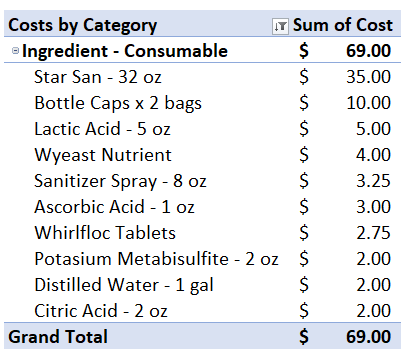
These are the boring items that you use up a little with each batch. Items like sanitizer, acids, water treatment, and bottle caps. These are also the little costs that can be easy to overlook. Most items here only add pennies to each batch, but if you purchase small bottles of StarSan and make up 5 or more gallons for every batch, the cost can pile up.
Take Away: My $69 in cost for these miscellaneous items seems pretty reasonable.
Homebrew Cost by Store
I thought it might be interesting to look at my cost per store. The table does not include my costs for Homebrew Events or Software and Subscriptions.
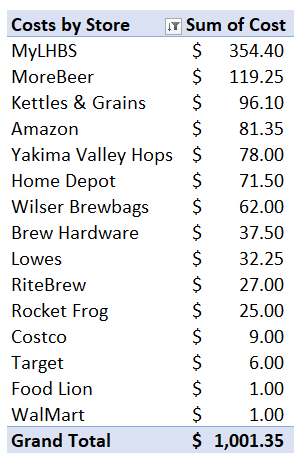
I do think it is good to vote with your dollars. If I spend dollars at a local small business, that money is going to support local families, toward building local infrastructure, or maybe to sponsor a local youth softball team. I try to support my local homebrew shops (one of which is actually named My Local Homebrew Shop, with Kettles & Grains being another one). I feel they provide a valuable service to me and the homebrewing community.
I am also not opposed to supporting online vendors that provide a quality product, a good price, and solid customer service. I have been a long-time customer of MoreBeer and I appreciate the support that Yakima Valley Hops provides to homebrewers. There are also some other small homebrew shops in the list like Wilser Brewbags, Brew Hardware, and RiteBrew. There are also the bags of hops I purchased from Rocket Frog, a now defunct local brewery.
Amazon is towards the top of the list as well. I have mixed feelings about Amazon. It can be hard to pass up the price, wide selection, and fast shipping. I have some concerns about the pressure on local shops. The $71.50 spent at Home Depot surprised me a bit, but they are just a couple miles down the road. I see another $32.25 at Lowes. Aside from that, the other stores are mostly local grocery stores and $9 at Costco.
Summary
What is my overall summary? Do I spend a lot of money on homebrewing? Am I saving money by brewing my own beer? A total of $2,120 seems pretty expensive, but it is only around $40 per week. Removing Homebrew Events and Software and Subscriptions lowers the cost down to $1,001, or under $20 per week.
I look at Homebrewing as a hobby. I checked a local golf course (not the one with Trump in the name) and I saw “initiation” costs over $25,000, and annual dues of over $5,000. I am well below those costs! As a hobby, Homebrewing is seems pretty reasonable.
In the next article in this series, I will take a different approach. I hope that looking at the details of every bath that I brewed in 2022 will give me a different view of my annual homebrew expenses. At least it will give me a little better feel for the ingredient costs per batch and the differences between various beer styles. Be sure to check that one out, and read the introduction article if you have not done so already.
Cover photo by Olia Danilevich (link)


